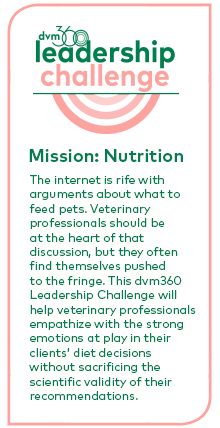Be the best source of pet food info for your veterinary clients
Vet teams: Dont underestimate the power of your guidance when encouraging pet owners to make objective decisions about pet food. Youre better armed than you think.

Maryna/stock.adobe.com
You know bad marketing surrounding pet food is everywhere-reaching pet owners via commercials, social media, influencers, digital advertising and, of course, word of mouth.
And yet, understanding how to "read" pet food labels and appropriately compare diets can be overwhelming to pet owners, especially given the amount of information provided on pet food products. Added to that, you know labels are used as marketing tools to influence pet owners' opinions and purchasing habits.
Veterinary teams should be the helpful guides in this journey. Here's how best to leverage your knowledge and efforts.
For the vet team: Understanding guaranteed analysis
While the guaranteed analysis (GA) is one of the many label requirements for manufactured pet food, pet owners often

use this to try to quantify nutrient amounts, such as protein, within the diet.
Unfortunately, the GA values are recorded as a percentage of weight as-fed -making it inaccurate to cross-compare, especially between dry and canned products due to the variation in moisture. To be able to effectively evaluate the nutrient levels between products, typical content of protein and fat can be calculated into grams/1000 kcal (see Table 1). Follow the steps below:
- Divide kcal/kg by 10,000 (kcal/kg will be listed on the bag).
- Divide estimated protein and fat percentage by the number obtained from step 1.
For example:
Guaranteed Analysis
Protein: 32% minimum
Fat: 14% minimum
Kcal/kg: 3,740
Protein:
Step 1: 3,740/10,000 = 0.374
Step 2: 32/0.374 = 85.6 g/1000 kcal protein
Review the chart below for the additional calculations and comparisons.
Nutrient of concern
GA-DRY
g/1000 kcal DRY
GA-CANNED
g/1000 kcal CANNED
Protein-minimum
32 85.6 10.0 67.7
Fat-minimium
14 37.4 9.0 60.9
kcal/kg
3,740 NA 1,477 NA
Table 1: Example comparison of canned and dry pet food when looking at the guaranteed analysis vs. g/1,000 kcal.
After doing the math for the examples in Table 1, you'll notice that the canned food contains higher fat but lower protein than the dry product. You might not be able to appreciate this when trying to compare GA-again, showing the inaccuracy of comparison based upon GA due to the variation in moisture content.
For the super-involved pet owner: Questions to ask
There are likely some clients at your practice you'd qualify as “super-involved” pet owners. For these types, who are looking to pursue a more hands-on approach and make a more informed decision when evaluating a company or brand of food, you can encourage a few things. The pet owner could call the manufacturer directly and ask a series of questions (see Table 2) recommended by the World Small Animal Veterinary Association (WSAVA).
Questions to ask pet food manufacturers, from WSVA1
Do you employ a full-time qualified nutritionist? What is their name and qualifications? Who formulates your foods and what are his/her credentials? Are your diets tested using AAFCO feeding trials or by formulation to meet AAFCO nutrient profiles? If formulated, do you meet AAFCO nutrient profiles by analysis of the finshed product? Where are your foods produced and manufactured? What specific quality control measures do you use to ensure the consistency and quality of your ingredients and the end product? Will you provide a complete nutritent analysis for the dog or cat food in question? What is the caloric value per gram, cup or can of the food? What kind of product research has been conducted? Are the results published in peer-reviewed journals?
Table 2: WSAVA recommendations on selecting pet foods.
Remind these clients that most pet food companies should be able (and willing!) to provide responses to the WSAVA questions. And if the company is unable or unwilling to provide a response, pet owners should take caution when considering those diets.
AAFCO considerations
“Does a guaranteed analysis tell you if the food is actually able to be digested? No. Does it tell you if the pet will actually eat the food, or if it's acceptable? No. Does it tell you if the ingredients are bioavailable, that the pet can actually utilize the protein source that's in there? It tells you nothing about any of that."
-Angela Rollins, DVM, PhD, DACVN, of the University of Tennessee, in a recent dvm360 article.
One of the WSAVA questions pertains to the Association of American Feed Control Officials (AAFCO). It's important to recognize that while AAFCO provides recommendations for states to consider as they update state feed laws, AAFCO does not regulate or inspect pet food.
Regulations and enforcement of pet food labeling is done mostly at the state level by state feed control officials; not by AAFCO, but generally following AAFCO recommendations. Nutritional adequacy of a pet food is labeled and written on the product in one of two ways.
- Formulated (by computer) meeting an AAFCO nutrient profile (growth and reproduction or adult maintenance)
- After formulation, a feeding trial where the specific food has been fed to animals in a controlled setting while monitoring specific response parameters. [Note: While this information can be found on the product, following up with the company to verify analysis of the finished product(s) may influence final product selection.]
Another requirement on pet food labels (with the exception of therapeutic foods) is feeding guidelines that include quantity and frequency. However, these are guidelines, and when possible, adjusting the energy intake to meet the individual pets' needs should be considered.
It's crucial that vet teams obtain an accurate patient history that accounts for diet, supplements, treats and foods used for medications, which will help guide appropriate feeding recommendations. In general, the balanced diet should account for 90% of food intake per day, with treats and/or supplements as less than 10% of the total daily energy needs. When the animal is of ideal weight, feeding recommendations should match their current calorie intake. When the pet is over or underweight, adjusting current intake to meet the desired effect can provide a tailored plan to best meet the patient's needs.
Dare to ask (the tough questions)
Choosing a pet's food often is an important part of the pet owner's relationship with their dog or cat. That's why encouraging and educating pet owners to base their decisions on objective information, like the WSAVA questions-and less on the ingredient list or website ratings-can empower them to make an informed decision for their pet.
Recently, the Pet Nutrition Alliance (PNA), an independent, nonprofit organization, launched a resource for veterinary professionals called “Dare to Ask.” This resource provides more than 200 manufacturers' responses to questions about their nutritional expertise, their ability to provide nutrient information when requested and where the pet food is manufactured. “Dare to Ask” can provide important details to guide selection of pet food without influence from marketing.
Ultimately, educating owners to seek out facts, beyond the label, and ask specific questions in order to obtain as much objective information as possible, will surround them with the knowledge they need to select the most appropriate diet for their beloved pet. Remember, your guidance goes a long way.
Reference
1. WSAVA. “WSAVA Global Nutrition Committee: Recommendations on Selecting Pet Foods.” World Small Animal Veterinary Association , 2013, www.wsava.org/WSAVA/media/Documents/Committee%20Resources/Global%20Nutrition%20Committee/English/Selecting-the-Best-Food-for-your-Pet.pdf.
Ashley Cox works for the nutrition service at the University of Tennessee College of Veterinary Medicine.